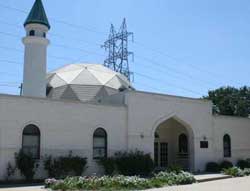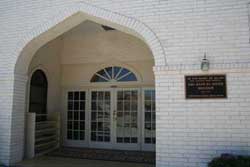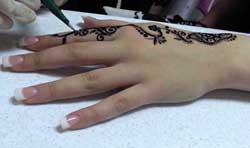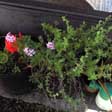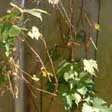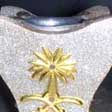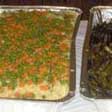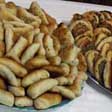Domestic Customs Among Muslim Women In The Greater New Orleans Area
By Denese Neu
Just beyond the geographic boundaries of New Orleans, in Jefferson Parish, Louisiana's most diverse parish, is a suburban area with a large concentration of Muslim immigrant residents. This community is served by the mosque Masjid Abu-Bakr Al-Siddiq, which sits at the corner of Power Drive and Esplanade Avenue in Metairie. It is the only one in the New Orleans area built specifically as a mosque. The building possesses a geodesic dome and single minaret, yet the crescent moon which is an internationally-recognized symbol of the faith of Islam is notably absent within the architecture. As one pulls into the mosque's driveway, the gate topped by the ubiquitous fleur-de-lis is notable. Omar Suleiman, the Imam (spiritual leader), explains that the gates were added for protection after the mosque was vandalized several times following the September 11th attacks. This symbol and statement lay the framework for learning about this new group of area residents and how they continue the traditions of their native countries while living in the New Orleans area.
This mosque serves as both the spiritual and cultural center for approximately 300 families from a variety of countries. The membership makes it the largest mosque in Louisiana. Most mosques, in areas with large Muslim communities, are built around a Muslim community from a particular place of origin. Because Louisiana's Muslim communities are relatively small, each mosque serves worshippers who come from a variety of places. In addition to describing the community demographics, the Imam explains that there is a "communication catastrophe between the older generation and the younger generation" regarding the community's struggle to reconcile the old traditions and cultures with the elements of American lifestyle adopted by younger members.
For example, he explains that it isn't uncommon for some men to arrive at the mosque wearing New Orleans Saints jerseys. For the women who arrive wearing American-style clothing, coverings are provided. According to the Imam, it is primarily women who serve as the cultural bearers by organizing events and teaching folk traditions to the children.
Islam And The Muslim Population Of Southeast Louisiana
In order to learn about the cultural traditions of immigrant Muslims, one must be respectful of the additional challenges presented by the September 11th terrorist attacks. Within the Muslim community, the social response to these attacks was to become more protective, private, and insular. The people who chose to participate in this project all shared stories of investigations, verbal abuse, frustrating accusations aimed at their community, and the desire to be able to freely practice their traditions and religion. They overcame initial responses of mistrust and fear in order to share their own experiences of Muslim tradition with others. Amal Bensrieti, a political refugee from Libya, spent a great deal of time explaining what is like to live as a Muslim in the United States. "I'm really glad that someone is taking an interest in us. We are always negative topics."
The story of the transnational Muslim community is multi-faceted and rich in folk artistry that is colorful and beautiful. Beyond the food from popular Middle Eastern restaurants, Muslim cultures and customs are largely unknown to the non-Muslim residents of southeast Louisiana. Many of these new residents came to Louisiana for reasons similar to those of other New Orleanians from around the globe and New Orleanians who migrated elsewhere. They lost their homes and livelihood as a result of tragic circumstances beyond their control. Today they are learning to navigate the United States' modern, ever-shifting culture while struggling to maintain the familiar customs, traditional religious practices, and value systems of their native homelands.
The Imam explained that "an Islamic culture" does not exist. Islam is a way of life; therefore, the traditions of Islam and the country or region of the world are interconnected but vary as they blend with traditions of the various countries in which Islam is practiced. He also explained that Islam includes practices that can be considered cultural art forms. These include archery, religious ceremonies, Arabic calligraphy, and traditions of the spoken word such as chanting and poetry reading. Enriching these traditions are the cultures of the native countries of the immigrant Muslim community. Two examples are belly dancing and the dances of the Whirling Dervishes. Muslim women do not entertain publicly, but non-Muslim dance studios teach some of the dances and non-Muslim entertainers perform them for public audiences. Some Muslim women learn belly dancing in their native country and perform privately in the home or at all-female celebrations. Though many Westerners believe the "Whirling Dervishes" to be Muslim, this dance is a tradition only in Turkey and springs from Sufi, an expression of Islam.
Some participants in this project converted to Islam upon marriage and some are American-born citizens. Because of the need to protect their community, these women volunteered to serve as guides to understanding the culture and issues of the immigrant population. One woman, born and raised in Illinois, converted to Islam to marry an Iraqi man. The daughter, Sara Al-Dahir, lived in Iraq until the age of four and grew up in the United States when the family had to leave for personal safety reasons. She describes her American home as Iraqi; because her father intended to return, he never adopted American ways. Another woman, Jenny Yanez, is a Spanish immigrant whose parents hail from Spain and Cuba. The family converted to Islam and they have adapted their Spanish traditions to accommodate their Islamic way of life. These three women are members of Masjid Abu-Bakr Al-Siddiq and were asked by the Imam to assist this interview project. They provided the cultural, political, and religious background that will allow interested outsiders to better understand the nuances of the community. Additionally, they explained that marriage to a Muslim is allowed for outsiders but requires conversion to the religion. As a result, the folk traditions of the native Muslim's country might be stronger in the household than the traditions of the American-born spouse convert.
Louisiana's natural resources were a draw for Muslim immigrants. During the 1960s and 1970s, Louisiana attracted engineers because of the oil industry. Area universities actively recruited overseas and many Middle Eastern governments paid to educate their citizens in the United States, with the goal that they return home. Some Muslims arrived as transient students, and others came as professionals and chose to stay. As professionals established themselves in the area, they also opened businesses such as stores, gas stations, and restaurants. These economic opportunities helped secure visas to bring additional family and clan members to the United States. Clan refers to villages comprised of extremely extended family (such as 7th and 8th cousins). Many settled in towns surrounding New Orleans, especially Chalmette and those on the West Bank of the Mississippi River.
In the 1980s, the Saudis had a strong presence in the area and had a social club called the Saudi House for Gulf Arabs. This club no longer exists but it was the cultural gathering place for Muslim immigrants. The club donated a mosque in the university area of Uptown New Orleans which continues to serve the transient student population. Beginning in the 1990s and continuing through the present, southern Iraqis (Shiites, a minority sect of Islam) were sponsored to immigrate as refugees. This immigrant population is mostly educated, although out of necessity many work in jobs that do not utilize their education, such as driving cabs.
Besides American-born Muslims, the three largest Muslim groups in Southeast Louisiana are Palestinians, Iraqis, and Pakistani-Indians. There is also a segment of Northern African Muslims who are Arab and come from Libya, Tunisia, Egypt, Morocco, and Algeria. Each group practices the traditions of Islam and also brings the cultural traditions of its native country to the area.
Religion And Traditional Textiles
The hijad, the woman's headscarf, may be the most recognized symbol of Islam. These scarves range from very simple mass-manufactured items to intricate hand-embroidered designs. Many wear handcrafted scarves with tatted edges or embroidery but this art form is not widely practiced in Louisiana; most purchase them from their native country or stores. A few Algerian immigrants continue to practice the tradition of embroidering the hijad. The embroidery and style differs among countries and some patterns are traditions of a clan. This article of clothing is a choice that can be styled in a variety of ways. Some of the styles come from particular countries or villages and are adopted by others through cross-cultural sharing. So some styles of wearing the scarf can be considered a folk tradition, however other styles are created for fashion, ease, or comfort. Members of this community who were interviewed requested that the traditional styles of wearing the hijad associated with native places not be photographed.
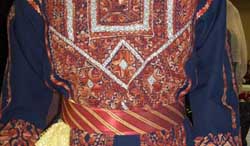
The textile art form most widely practiced in the area is Palestinian cross-stitching. Called tatreez, it is the most indigenous form of art from Palestine. It is practiced by the women and adorns a variety of articles (such as table runners), but it is most commonly done on the floor-length, long-sleeve traditional dresses called thobes that feature blocks of elaborate cross stitch on the front, sides, and/or sleeves. They may be made from cotton or wool while others are cut from silk or velvet. Naheda Esmail, a Palestinian woman who immigrated to New Orleans in 1977, has kept the culture and practices of her native country along with her cousin and others who practice cross-stitching, primarily on thobes. Although the cross-stitch itself is very simple (it is simply an X), the intricacy of the patterns requires a great deal of time to complete. Mrs Esmail learned cross-stitching from her mother in Palestine before moving to the United States 20 years ago. A single dress can take five to eight months to complete; longer if the woman is employed outside the home. Because of the time investment, the women often work together on cross-stitching projects.
Palestinian Wedding Traditions
As in all religions, weddings combine sacred ritual with family and community celebration. The ceremonies are centered on the religious rite but the service and celebration usually incorporate cultural traditions and customs of the bride and groom's heritage. The Muslim wedding is a grand affair and has three phases: pre-wedding, wedding, and post-wedding. Each one consists of particular rituals. Beyond this, the Muslim wedding traditions reflect the diversity of the Muslim world and they vary based on the country of origin and ethnicity. For example: an Indian Muslim wedding greatly differs from a Palestinian Muslim wedding. These differences are apparent in the clothes, decorations, food, music, and social customs.
The Palestinian wedding celebration is a three-day affair of hospitality, a virtue of Islam. The generosity of food and gift were displayed throughout the festivities. Most brides have a henna party, a pre-wedding event for women only, where they gather to dance, eat, and have henna designs applied to their hands. This celebration features several cultural traditions, from the foods that were prepared by women of the community to traditional dances. At a Friday night pre-wedding party in April, 2009, at a country club hall, many women wore thobes while the younger women were mostly dressed in American-style clothing. Most wore headscarves, but not all. Many women sat and visited with each other while others danced to pre-recorded Middle-Eastern disco. As the dancing continued, a few belly dancing belts were passed around and accepted. These gold belts adorned with coins were placed over the woman's dress and she proceeded to dance. At this private celebration of women, some women felt free to demonstrate their skills in this folkloric Middle Eastern dance. Belly dancing is a talent gifted to only some, but all appreciate watching the dancers and all move to the music. Called raqs sharqi (the improvisational solo dances best known by Westerners) or raqs baladi (an improvised social dance at gatherings), this dance has many regional forms with distinctive dance moves.
Much of the dancing at the henna party was the dabka, the most popular folk dance among Middle Easterners. As a line dance, the women formed circled and proceeded to stomp the ground in rhythm to the recorded music. Square pieces of bright, colorful cloth were passed around to the dancers who held them up and waved them to the rhythm. Vocalization of the dancers and watchers added to the energy. This Palestinian custom is very similar to the use of the white kerchief used during a New Orleans second line. The dancing continued as individuals waited for henna application. After a few hours, the men arrived to participate in the meal. Upon their arrival, the music and dancing stopped. The men were served first and seated themselves in a separate room. The women then lined up at the buffet table covered with traditional foods.
The central purpose of this party is the application of henna designs to the bride's hands. The use of henna is a folkloric tradition that can be traced back to ancient civilizations. The art form has been adopted as a mainstream trend but the significance of the practice remains strong among the Muslim immigrant communities. The henna plant is believed to bring love and good fortune, and to protect against evil. This belief makes it easy to understand why is has been traditionally practiced for wedding celebrations. After completing the bride's hands, women and girls patiently waited their turn. As henna artist Lema Hamdah applied these temporary works of art at a recent wedding party, she did not use a pattern but had her own particular style. A book of designs sat nearby. It held patterns of butterflies and flowers along with some sketches by the artist, but no one selected from the book. The artist worked for several hours hunched over the hands and only took a break when the meal was served. The young girls were awed by how effortlessly she created the art. Lema again applied henna to the hands of wedding guests at the next night's wedding celebration.
The Saturday night henna party was held in the ballroom of a downtown hotel. A live band was flown in and performed for the hundreds of guests in attendance. As guests arrived, many of the women, wearing elaborately decorated thobes, took to the dance floor and again formed the circle for dabka. The energy of the rhythm climbed as they awaited the arrival of the bride and groom. Keeping with tradition, close family members escorted each of them into the ballroom and onto the dance floor. All of the guests stood and cleared a way to allow the couple to dance. For several minutes they danced alone and then slowly they were joined by immediate family. After a short while, everyone who wished to dance had joined the celebration. Plates of pastries arrived on the tables and guests were provided tea and coffee as the dancing and rituals continued until the meal was served. Following dinner were more songs and dancing. On the following day, the guests gathered again for a more formal celebration of the marriage.
Self-Taught Henna Artistry
Lema Hamdah moved to New Orleans from Palestine after her marriage seven years ago. She is a quiet woman with a generous spirit and a sense of modesty that makes her reluctant to be photographed. In addition to her self-created designs for henna tattoos, she also draws and works to develop herself as an artist. One of her sketches is of a fleur-de-lis that she adapted from an image she saw at the New Orleans French Market. Other sketches are of people and flowers, and a few are recognizably Palestinian images. One of these, she explained, depicts the strife of her homeland. Within her artwork are some of the motifs that appear in her henna patterns. Lema learned henna techniques only after moving to New Orleans and receiving requests from other women at the mosque who admired her drawings. She is now asked to do henna at parties a few times a month but limits this to parties for friends. The best atmosphere, one in which Lema feels comfortable and can really concentrate on her designs, is achieved among groups of women she knows.
As a self-taught henna artist, Lema is helping to keep the tradition of Palestinian henna alive. She knows of only one other woman at her mosque who does henna; she is Pakistani. Although uncertain about the details, Lema explains that patterns and designs are different, based on a woman's origins. The more elaborate henna designs are traditionally from India and Pakistan. In other Middle Eastern countries, the henna wedding tradition is simpler, sometimes simply a red dot in the palm. More recently, the elaborate designs are spreading into other areas and groups. She describes her technique as free-form, in which she begins to draw and does not really think about what she is fully preparing. For brides, however, she creates a sketch to assure her work. This sketch will be approved by the bride and other significant women and will allow her to avoid errors during application. Her technique includes particular patterns, such flowers, wavy lines, and curls. Using a store-bought kit, she starts with a simple flower then applies the design up the finger and onto the hand. Each step appears effortless as she adds the waves, curls, and more flowers. She might extend the motif to a second finger, and most designs stretch from the wrist to the cuticle. She finishes the art with small, precise dots that border the primary elements within the design.
The tool she uses is similar to the cone used for cake decorating. It is a squeezable cone with a pen tip for application. The henna is not expensive and one cone will last for approximately 60 applications. In addition to applying the pattern, Lema also advises on how to preserve the henna art. The longer the ink is on the hand, the darker the design. The ink should be allowed to fully dry and should not be washed off quickly. Applying a damp paper towel to remoisten the ink will also help set the design. Because henna is considered auspicious by many, the women take steps to make it last longer. They might cover their hands to keep the ink on overnight and take precautions to reduce unnecessary contact with water.
Lema is not offended that henna has become a fashion in the United States. As a Muslim, she explains that she would not apply henna to a man because there are religious beliefs about touching, although she does apply henna to non-Muslim women. If someone asked her to apply a henna design other than her own, she would restrict drawing to what is culturally acceptable. She explains that she would not apply foul language or images of alcohol, which are forbidden in Islam.
Hospitality, Food, Home, and Clothing
In any culture, food is always important for maintaining identity and a sense of community. For Amal Bensrieti, cooking and baking traditional Libyan foods are sources of solace. She maintains an Arabian herb garden in her backyard. There she grows special mints from Africa and Jerusalem in addition to marjoram and rosemary. The herbs are grown in pots around her patio and are easily accessed from the kitchen. She also grows grape vines along her fence. These are for the leaves, which she stuffs with a rice mixture to make dolmas. This is a common practice within the community to ensure that they have the ingredients for their traditional. They also grow a special type of spinach and other vegetables common to Middle-Eastern cooking.
Within the Muslim community, food is integral to hospitality. Sharing is a custom and so it is standard practice to open one's home and offer the best one has. At a gathering at Jenny Yanez's home, the coffee table was covered by home-prepared food, including traditional Middle-Eastern and Spanish foods. The food served were savory and sweet finger snacks prepared and served by the hostess and her mother.
Items included empanadas (a Spanish fried stuffed pastry), baba ghannouj (an eggplant dip served with pita), and fresh citrus slices. The hostess offered a choice of coffee and tea to her guests throughout the morning. These beverage choices were ordinary American versions. As it was served, the women described the Arabian coffee ceremony that is often a part of accommodating guests. It is informal and cardamom green coffee is served throughout the hours long gathering. Incense is also burned and the guests position their face near the holder and wave the smoke toward their nose.
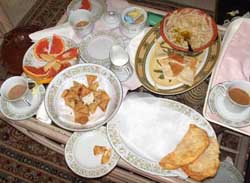
Food also plays an important role in religious holidays, particularly those that require fasting before a culminating feast. Sara explains the primary holidays and the decorative cooking associated with them. Eid is an Arabic word meaning festivity. Eid ul-Fitr is a Muslim holiday that marks the end of Ramadan, the Islamic holy month of fasting. The second, and larger festival, is Eid al-Adha which translates as the festival of sacrifice. It begins approximately 70 days after the end of Ramadan and lasts for three or more days. It is the celebration that starts the Hajj, the annual pilgrimage to Mecca in Saudi Arabia.
To prepare for these festivities, the women gather to prepare the traditional foods of the feast days including sweets, dolmas (stuffed vegetables), and meats. A table should be covered entirely with food, as the hostess is considered stingy if her table can be seen. Dolmas (or dolmades) serve as the centerpiece and the food is decorated with nuts, raisins, and dates. Most westerners know dolmas as stuffed grape leaves but, according to Holly Al-Dahir, this term refers to any elaborately stuffed vegetable. While some families have resisted adapting recipes to include New Orleans ingredients, some have experimented. Lema Hamdah keeps her traditional recipes but also uses some Cajun-style spices in some of them.
The community also prepares other traditional foods to eat at home and to share at celebrations. These include the popular Palestinian dish maqluba, which is Arabic for "upside down." It is a one-pot dish of meat, rice, and vegetables. After preparation, the meal is flipped onto a platter and served with a side of yogurt. Another popular dish is mansaf. It is a traditional lamb and rice dish that is served on special occasions and main holidays. Palestinians also enjoy a special dish, emsakhan, which they describe as their version of pizza. It is a specialty bread item cooked with onions, spices and olive oil; another specialty bread is sfinz, a Libyan tradition. It can be served savory (filled with eggs) or sweet (covered with honey or sugar). This item plays a role in the Libyan folktale Sabe'a Sabaya about greed. And lastly, there are the traditional desserts hilba (cakes) and mutabak (sweet or savory pastry turnovers usually stuffed with cheese, banana, or meat).
Domestic customs within Muslim immigrant homes vary according to the cultural traditions of the home country and family. Homes are decorated with art from the place of origin but cannot include images of ordinary human beings and animals. Islam prohibits depictions of humans or animals because these images might result in idol-worship. As a result Islamic art uses geometric, arabesque, floral, and calligraphic forms. In addition to art, other cultural traditions are incorporated in the home.
For example, Sara indicated that she has a formal Arab sitting room decorated with carved wooden arabesque furniture. With regard to dress, Holly explains that many men wear American-style clothes to work but change into traditional dress at home. Sara adds that women have a great deal of choice with regard to clothing, but adornment almost always is within the cultural customs of the native country. Many purchase clothes and bring them back from visits from the Middle East. The women often add embroidery and beadwork to dresses to make them fancier.
Teaching Cultural Traditions
The mosque, in addition to serving as the community's spiritual center, also provides education to the children. Many of the women volunteer to teach traditions such as Arabic calligraphy. The mosque also supports the Islamic School of New Orleans where the children are educated within the Islamic environment. The school is all Muslim but very multi-cultural because of the diversity of Muslim immigrants. Estimates are that 70% of students are first generation, 20% American born, and 10% transient (the children of people living in the area while pursuing higher education). The parents volunteer to teach physical education and art so that the professional teachers can focus of delivery of the curriculum.
Physical education and art instruction are associated with the culture of Islamic countries and traditions of Islam. For example, archery is taught and practiced because it is an Islamic physical art. Calligraphy, oral traditions of poetry, dances, and traditional tile painting are incorporated into the curriculum. Each Spring, the Islamic School of Greater New Orleans has a heritage fair that is open to the public. The fair is an excellent example for observing and appreciating the diversity of cultures within the larger Muslim community. The children all wear the traditional clothes of their native land and do a presentation on their customs. It is important to the parents that the children have cultural education beyond that of Islam. They visit museums and engage in other physical activities, such as soccer. Teaching modesty within Islam can be challenging, particularly as the girls assimilate to the larger culture while also living the Muslim life.
The transnational Muslims living in the New Orleans area maintain rich folk traditions. During a time when many have not been accepting of them, their traditional culture has helped develop a strong community and perhaps helped them preserve traditions of their native places more than if assimilation were eased. As we learn more about the traditions and customs of these new immigrants, it is likely that they will find a way to negotiate between their religion and with those outside their faith.


